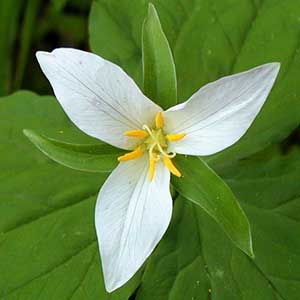Trillium ovatum
Trillium lancifolium
Pacific trillium, trillium, western trillium, western wake-robin, western white trillium, white or western trillium, white trillium
lance-leaf trillium, lanceleaf wakerobin
1–2, round, 2–5 dm, ± slender, glabrous.
1–2, round in cross section, 1.5–3.2 dm, ca. 2.5–3 times longer than bracts, slender, glabrous.
sessile, subsessile, or short-petiolate;
blade medium green, sometimes blotched and mottled, main veins prominent, ovate-rhombic, 7–12 × 5–20 cm, continuing to expand during anthesis, base rounded, apex acuminate.
often downturned but leaves held well away from ground, sessile;
blade mottled darker green, mottling becoming obscure in age, lanceolate to narrowly lanceolate-elliptic, 5–8.3 × 2–3.3 cm, not glossy, apex blunt or acute.
erect or nodding, odorless;
sepals spreading to horizontal, green, lanceolate to oblong-lanceolate, 15–50 × 6–20 mm, margins entire, apex acute;
petals erect-ascending, usually wide-spreading from base, exposing entire pistil, white or with pink or blush markings, lacking V-shaped markings, fading to rosy pink, purple, or dark red, veins not deeply engraved, ± linear to widely obovate, 1.5–7 ×1–4 cm, widest at or above middle, thin-textured, margins flat to undulate, apex acuminate;
stamens prominent, slightly recurved-spreading to straight, 10–18 mm;
filaments white, shorter than anthers, slender;
anthers yellow, 4–16 mm, slender, dehiscence latrorse-introrse;
ovary green or white, ovoid, 6-angled, 5–12 mm, attachment ± 3/4 ovary width;
stigmas recurved, barely connate basally, greenish white or white, linear, not lobed adaxially, 6–10 mm, uniformly thin;
pedicel erect to leaning, 2–6 cm.
erect, no odor reported;
sepals recurved basally and declining to ± same plane of and alternating with leaves, green, lanceolate, 13–20 × 5–7 mm, margins entire, apex acute;
petals long-lasting, erect, ± connivent, not fully concealing stamens and ovary, maroon-red, purple, greenish tan, or 2-colored, claw dark reddish maroon basally, often twisted, linear to narrowly spatulate, 2.8–6.6 × 20–40 cm, widest above middle, thick-textured, basally clawed, margins entire, apex acute, claw to ± 1/2 as long as expanded limb;
stamens incurved, 13–21 mm;
filaments purple, slender;
anthers weakly to strongly incurved, purple, 4–6 mm, ± slender, dehiscence introrse;
connectives weakly to strongly incurved, purple, extending 1 mm beyond anthers;
ovary dark purple, ovoid-rhomboid, 6-angled, 6–7 mm;
stigmas erect, somewhat divergent-recurved, distinct, purple, nearly linear, obscurely subulate, 3–4 mm, weakly fleshy.
baccate, green or white, ± odorless, broadly ovoid, obscurely winged, 1.2–2.8 × 0.7–1.9 cm, pulpy-moist.
baccate, purplish, odorless, 6-angled, prolonged angle folds making fruit appear almost winged, 0.7–1.2 cm, pulpy.
semierect to horizontal, short, stout, praemorse.
horizontal, white, very slender-elongated, brittle;
internodes elongated.
= 10.
= 10.
Trillium ovatum
Trillium lancifolium
Varieties 2 (2 in the flora).
(Discussion copyrighted by Flora of North America; reprinted with permission.)
Trillium lancifolium occurs mostly in small, regionally disjunct populations.
(Discussion copyrighted by Flora of North America; reprinted with permission.)
1. Bracts sessile; petals lanceolate to obovate, 1.5–7 × 1–4 cm | var. ovatum |
1. Bracts distinctly short-petiolate; petals linear to linear-lanceolate, 0.5–2.4 × 0.2–0.6 cm | var. oettingeri |
- Local floras:
BC,
CA,
OR,
WA
- Local Web sites:
CalFlora,
CalPhotos,
Flora NW,
PNW Herbaria,
Turner Photog.
WildflowerSearch
iNaturalist (observations)
USDA Plants Database
- LBJ Wildflower Center
- SEINet
- Plants of the World Online
- Encyclopedia of Life
- Wikipedia
- Google Image Search


